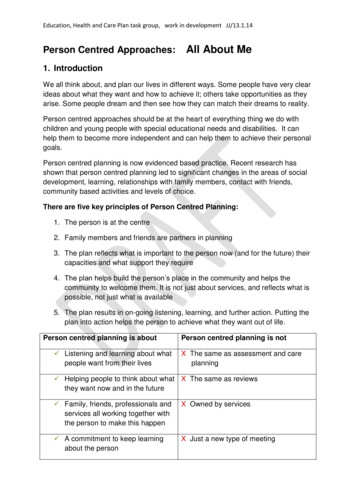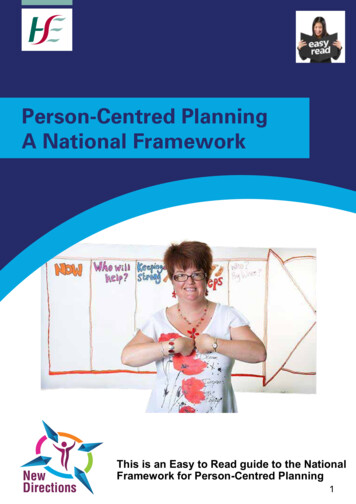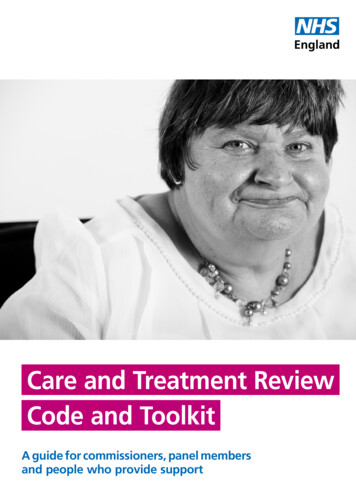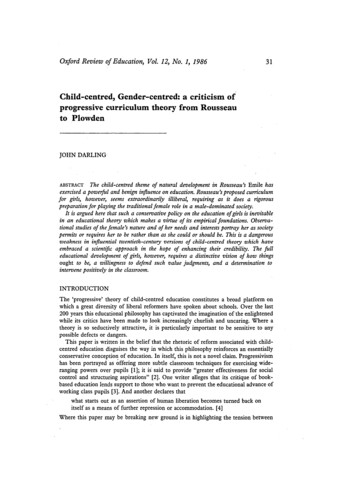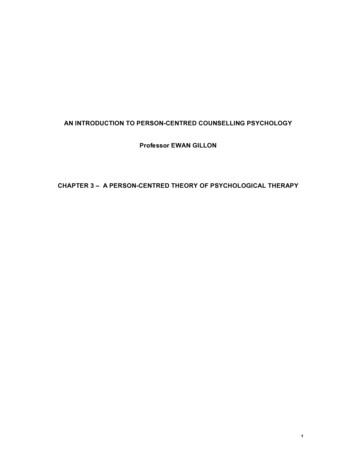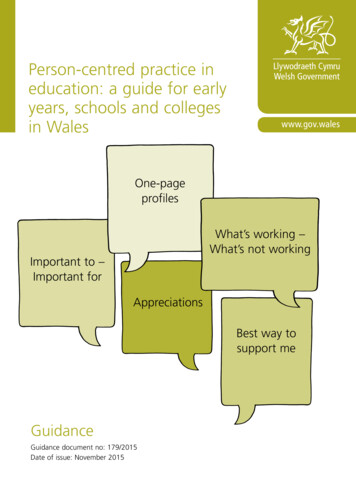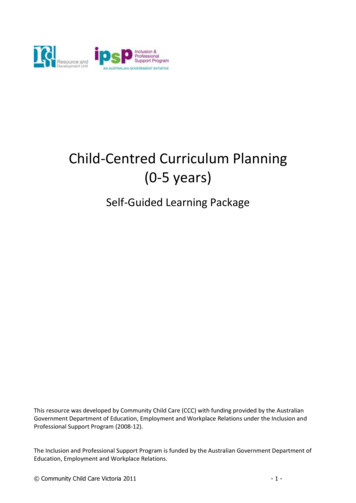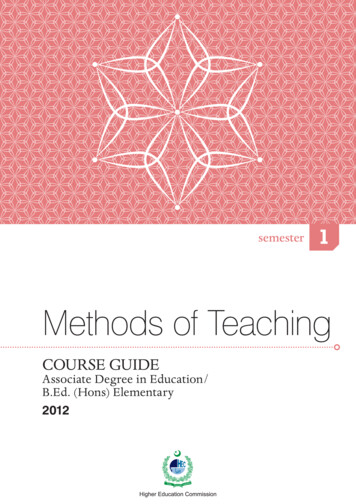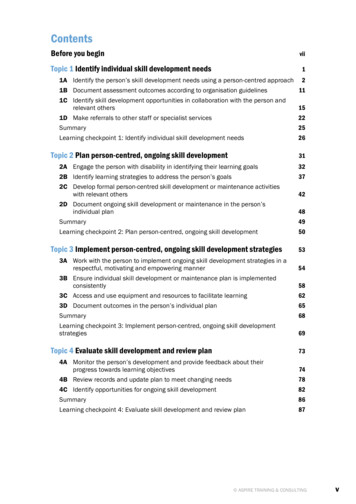
Transcription
ContentsBefore you begin viiTopic 1 Evaluate and prioritise the needs of a person with complex supportissues 11A Identify and prioritise the needs and coexisting issues of the person 21B Identify specific problems, issues and challenges for the person 81C Analyse and interpret data with assistance from health professionals 131D Recognise the impact of complex support issues on the person’s family 161E Establish priorities for support with the person and relevant others 19Summary 22Learning checkpoint 1 : Evaluate and prioritise the needs of a person withcomplex support issues 23Topic 2 Develop an individualised plan to achieve maximum quality of life 272A Use best practice guidelines to develop strategies to address complex and/or special needs 282B Liaise with relevant experts when developing individualised plans 332C Negotiate and establish goals 362D Access and negotiate resources to deliver identified services 382E Access community support agencies to facilitate the achievement of goals 41Summary 43Learning checkpoint 2: Develop an individualised plan to achieve maximumquality of life 44Topic 3 Coordinate the delivery of the individualised plan 473A Ensure services and support activities are undertaken by appropriatelyskilled workers 483B Recognise when a service and/or support worker is unable to provide thelevel of service required 513C Support stakeholders providing a service to understand their roles andresponsibilities within the plan 53Summary 55Learning checkpoint 3: Coordinate the delivery of the individualised plan56 v
Topic 1In this topic you will learn howto:1A Identify and prioritise theneeds and coexisting issuesof the person1B Identify specific problems,issues and challenges forthe person1C Analyse and interpret datawith assistance from healthprofessionals1D Recognise the impact ofcomplex support issues onthe person’s family1E Establish priorities forsupport with the person andrelevant othersEvaluate and prioritisethe needs of a personwith complex supportissuesA person with complex support issues typicallyhas a number of areas of need and various issuesthat need to be carefully identified and prioritised.The process of prioritising means that the mostimportant and time critical issues are assessed first,often using data that is provided by allied healthprofessionals or medical professionals. This processmay demand support and assistance from otherprofessionals as well as from family members orcaregivers and from the person.Prioritising issues and areas of need allows forthe development of an appropriate plan that takesinto account individual requirements and availableresources and support services. It is important,during the process of evaluating and prioritising theneeds of a person with complex support issues, torecognise the impact these issues may have uponfamily members. 1
CHCDIS010 PROVIDE PERSON-CENTRED SERVICES TO PEOPLE WITH DISABILITY WITH COMPLEX NEEDS4Collect and collateCollect and collate information from the formal and informal assessmentsprovided by stakeholders.5Identify and complete gapsIdentify any gaps in knowledge about the person and collect furtherinformation, as needed, through formal and informal assessment.Formal assessmentFormal assessments can provide information about many aspects of daily functioning,specific needs and health and related information. They should only be completed bypeople who have the necessary skills and knowledge to use the assessment tools.Many assessment tools require specific levels of qualification or experience before theycan be used – check your own workplace requirements for using formal assessments.Here are three types of formal assessments that may be used with people who havevarious types of disabilities or needs, or who are from specific cultural backgrounds.Mental state examination (MSE)XXAn MSE gives a snapshot of a person s psychological functioning at a particularpoint in time and can indicate if referral or risk assessment is needed.Australian community care needs assessment (ACCNA)XXThe ACCNA provides a consistent tool that is used across many service types tocollect and record information about the person and their carer (if relevant).Indigenous risk impact screen (IRIS) and brief interventionXXThe IRIS screening tool assesses risk for alcohol, drug and mental health issuesin Aboriginal and Torres Strait Islander peoples.Informal assessmentMany workers use informal assessments every day, often without even realising it. Theobservations we make about a person and the things they tell us about their needshelp create a picture of how to best provide support and assistance.Informal assessments may be created within the workplace or they may be comprisedof the notes and observations you make during an initial meeting or conversation.Elements of an informal assessment may include:written notes about what the person tells youXX observations of their mobility and independenceXX observations of the physical assistance required to perform activities of daily livingXX discussion of how their needs impact upon their activitiesXX discussion of their goals and requirementsXX information given to you by family members or advocatesXX answers given to questions you ask about care and support needs.XX4 ASPIRE TRAINING & CONSULTING
CHCDIS010 PROVIDE PERSON-CENTRED SERVICES TO PEOPLE WITH DISABILITY WITH COMPLEX NEEDSSome coexisting issues that must be considered are:presence of mental/physical health conditionsXX transport difficultiesXX social or geographical isolationXX financial considerations/level of debtXX religious or cultural requirementsXX carer or other family responsibilities.XXPrioritising needsIt is important to prioritise needs when providing care and support for a person.Identify the needs that are most important – these are the needs that must be dealtwith first. Care and support may be required for a short period of time, such as inresponse to a crisis or as part of a planned respite or short-term activity. Sometimesongoing care is required to support daily activities or a regular schedule of tasks suchas employment, recreation or personal care requirements. Establishing how urgent theneeds are determine the priority of meeting a person’s needs. Here is an example ofhow needs can be prioritised.Crisis supportCrisis support can be provided to help manage a short-term crisissuch as a family illness, change to living situation or a suddenchange in health status or care needs.Intermittent careIntermittent care can be provided from time to time, when required;for example, if a person’s condition exacerbates or when they arehaving respite care.Transition careTransition care facilitates the transition from one setting toanother, such as moving from home to a residential setting.Ongoing supportOngoing support happens according to a regular planned schedule,such as weekly or daily care, to ensure the maintenance of usuallife functioning and arrangements.6 ASPIRE TRAINING & CONSULTING
CHCDIS010 PROVIDE PERSON-CENTRED SERVICES TO PEOPLE WITH DISABILITY WITH COMPLEX NEEDS1BIdentify specific problems, issuesand challenges for the personCare and support must be provided in line withperson-centred practices. This requires focusingon individual support requirements and needs.Sometimes, a person may have specific issues orchallenges in their life that need to be identified.These may relate to their disability or condition, orthey may be a feature of their particular situation.Knowing what these issues and challengesare can help you plan the delivery of servicesaccording to individual requirements. When youidentify issues and needs of a person in your care,make sure you consider the limitations of yourown job role, follow organisational procedures and seek assistance as appropriate.Identify specific issues and challenges for the personThe issues and challenges experienced by a person may directly relate to a specifictype of disability or they may be typical of the disability or condition. This could includeproblems such as:accessing buildings and facilitiesXX finding an accessible toiletXX being treated in an unfair or discriminatory way.To identify specific issues and challenges for a person you are caring for it is importantto understand how physiology and psychology applies to their disability.XXHow physiology applies to disabilityMany disabilities affect the physiological functioning of the body; that is, the waythe body works at a system level (for example, respiratory, cardiovascular, endocrinesystems) and organ level (for example, the heart, lungs, skin or pancreas). It is usefulto understand how the human body functions and what happens to the various organsand systems when a disability is present. Physiological effects can range from mild toprofound.Here are some examples of how physiology applies to a range of disabilities.Disability typePhysical disabilityDepending on the type and level of physical disability, a person may display signsof a comprised musculoskeletal system. This may be identified by observing theperson’s mobility and their ability to complete manual tasks.Sensory disabilityDepending on the type and level of sensory disability, a person may display signs ofa compromised sensory system. This may be identified by the person’s inability totaste, smell, see or hear.8 ASPIRE TRAINING & CONSULTING
CHCDIS010 PROVIDE PERSON-CENTRED SERVICES TO PEOPLE WITH DISABILITY WITH COMPLEX NEEDSCommon issues and challengesA person with a disability may experience many issues and challenges. It is importantto understand and identify issues and challenges as soon as they arise. This enablesyou to predict difficulties and plan for issues should they occur.Here are some challenges and issues that may affect a person with a disability. Aperson with complex needs may have issues and challenges from several disabilitytypes.Disability typePhysical disabilityThe challenges and issues experienced by a person with a physical disability mayrelate to:XXaccessing services and public transport, etc.XXusing devises that require motor skillsXXcompleting compound actions, such as reaching and pullingXXmaintaining independence.Sensory disabilityThe challenges and issues experienced by a person with a sensory disability mayrelate to:XXsight: reading, walking, completing household tasksXXhearing: communicating within the community such as hearing public transportannouncementsXXtaste: completing household tasks such as seasoning foods, tasting foods(whether it is still good to eat)XXsmell: completing household tasks such as cooking; safety, such as smellingsmoke or gasPsychiatric disabilityThe challenges and issues experienced by a person with a psychiatric disabilityinclude the ability to :XXthink clearlyXXmake decisionsXXunderstand other people’s feelings or actionsXXshow emotionsXXcomplete self-care activities.Neurological disabilityThe challenges and issues experienced by a person with a neurological disability maybe:10XXloss of memoryXXattention deficitsXXincoherent speech. ASPIRE TRAINING & CONSULTING
Topic 1 Evaluate and prioritise the needs of a person with complex support issues1CAnalyse and interpret data withassistance from healthprofessionalsAllied health professionals and other workers can provideformal assessment information and data, which can assist indetermining the best way to provide support and care. Datamay be in the form of reports or assessments, and must beinterpreted carefully and appropriately by qualified people.Types of dataThere are many types of data that may be gathered, and depending on the type ofdata, it may be analysed and interpreted differently. Depending on the person, theremay be a range of people who contribute data to help evaluate the person’s individualneeds.Here are some types of data that may need to be analysed and interpreted, and whothe information may be supplied by.Types of data to analyse and interpretInformal written or verbal reportsInformal written or verbal reports provide brief information that is easy to interpretand understand.Supplied by: supervisors, other care workers and/or the family of the personreceiving supportMedical reportsMedical reports have more-complex information including specific medical language,facts, figures and numerical data.Supplied by: general practitioners, nursing staff, allied health professionalsFunctional skills reportsFunctional skills reports have information about how a person operates in varioussituations, such as walking skills assessments or transferring and mobility skillsreports.Supplied by: physiotherapists, speech pathologist, occupational therapistsRisk assessmentsRisk assessments provide information to staff about the relative risks of varioussituations, and how they should respond, such as the risk of a person falling.Supplied by: care service manager, supervisor, health and safety representativeIncidence and prevalence dataIncidence and prevalence data provides information about specific disabilities andhow frequently they occur among the population as a whole, or within particularcohorts such as children, adults or older people.Adapted from the Australian Bureau of Statistics: Disability,Aging and Carers, Australia: summary of Findings; www.abs.gov.auUNIT RELEASE 1 (ASPIRE VERSION 1.1) ASPIRE TRAINING & CONSULTING 13
ExampleTopic 1 Evaluate and prioritise the needs of a person with complex support issuesAnalyse and interpret dataYou work with children who have been identified as coming from ‘at risk’ livingsituations. Your supervisor has asked you to research a screening tool that can beused to identify any children who may have an as yet undiagnosed developmentaldelay or disability. You consult with the local community health centre and the earlychildhood intervention team in your area and seek their advice.They both recommend the PEDS tool (Parents’ Evaluation of Developmental Status)because it is simple, easy to administer and the data can be scored and interpretedin around five minutes. You trial the PEDS for severalweeks and then ask for feedback from parents,carers, staff members and your management team.The feedback is generally positive, so you write arecommendation that the PEDS tool be adopted as aregular aspect of service provision in your service.You also recommend that all staff be fully trained inadministering, scoring, analysing and interpreting theresults, and in knowing when and how to refer anyconcerns on for further evaluation.Practice task 3Read the case study, then answer the questions that follow.Case studyMavis works in a community day centre where she provides and facilitates recreationand leisure activities. She has been given a report regarding a new person in her careand is unsure about analysing and interpreting the data it contains. The report is calledthe Alzheimer’s Disease Assessment Scale (ADAS). Mavis has not seen an ADAS reportbefore.Mavis knows the report is about a person who is going to join the gentle exercise programon Thursday afternoon. She reads the scores, which have been written into a booklet,but realises that the report does not include a summary section or interpretation of theresults.She reads the testing booklet that includes the person’s responses, but there are nowritten comments or interpretations from the community services professional about theperson.1. To help Mavis understand the data in the report, who should Mavis contact first?2. Mavis is eager to have the person join her program but is unsure about what thedata means. What should Mavis do?Click to complete Practice task 3 15
Topic 1 Evaluate and prioritise the needs of a person with complex support issuesThere are two key concepts to help you understand complex support issues:‘Breadth of need’, which refers to multiple needs that are interconnectedXX ‘Depth of need’, which refers to the profoundness and intensity of needsConsider the following information.XXBreadth-wide range of areasBreadth-wide range of areas include the following:XXDisadvantageXXDisabilityXXHealth issuesXXHigh physical support needsXXMental support needsXXPovertyXXUnstable living situationXXFinancial difficultiesXXFamily violenceXXSubstance abuseDepth-complex impactsDepth-complex impacts include the following:XXSignificant impact on the person and their familyXXSerious issuesXXFar-reaching implicationsXXNot easy to resolveXXRequire careful and experienced planningXXRequire ongoing supportImpact of complex support issuesSupport issues for people with complex needs varyaccording to their environmental and societal context.For example, parents may find it a challenge to carefor their children with complex needs. Couples, whereone person has complex needs, may find they areunder extreme pressure and that their relationshipbecomes more conflict-ridden and unstable. Singleparents with complex needs may need to rely on familyand community support. Culturally and linguisticallydiverse (CALD) families are vulnerable to experiencing complex issues. Isolation andcommunication difficulties may manifest as depression and anxiety. Providing supportfor a wide range of issues requires a multi-service and integrated approach. 17
Topic 1 Evaluate and prioritise the needs of a person with complex support issues1EEstablish priorities for supportwith the person and relevantothersWhen working with a person who requires complex support, their needs must beprioritised so they are properly managed.Prioritising needs may be done in collaboration with other people, including the personthemselves, family members, health professionals and other stakeholders.Establish prioritiesSome support needs are time critical and urgent, and some family situations requireimmediate attention. Whatever the case, there should be a focus on trying to reestablish a safe, secure and appropriate family or living situation that is maintainablein the long term.Early priorities include basic areas such as food, shelter and safety; while laterpriorities include emotional and social support. Maslow’s hierarchy of needs illustratesthe level of an individual’s needs and can be used to systematically establish thepriority of needs.Seenllmulfilf f eedsntSelfactualisation:Morality, creativity,spontaneity, problemsolving, lack of prejudice,acceptance of factLove/belonging:Friendship, family, sexual intimacyalgicoloych dsPs neeEsteem:Self-esteem, confidence, achievement,respect of others, respect by othersPhysiological:Breathing, food, water, sex, sleep, homeostasis, excretionsicBa edsneSafety:Security of: body, employment, resources, morality, thefamily, health, property 19
CHCDIS010 PROVIDE PERSON-CENTRED SERVICES TO PEOPLE WITH DISABILITY WITH COMPLEX NEEDSPractice task 51. List three high-priority issues that need to be addressed when prioritising supportneeds in the individualised support plan.2. Describe two ways you can prioritise support when developing a support plan for aperson with complex needs and issues.Click to complete Practice task 5Summary1. People who require support services may have simple or complex needs. When aperson has issues that coexist, their needs become complex and the needs mustbe prioritised.2. An assessment takes place to identify whether a person’s needs are simple orcomplex. This may be a combination of formal and informal assessments.3. Analysing and interpreting data may be done with assistance and in collaborationwith others.4. It is important to understand the breadth and depth of issues that can affect aperson with complex needs and their family.5. Collaborating with others will help you to understand the needs of the personrequiring support and ensure the priority of support and level of support providedis appropriate.22 ASPIRE TRAINING & CONSULTING
CHCDIS010 PROVIDE PERSON-CENTRED SERVICES TO PEOPLE WITH DISABILITY WITH COMPLEX NEEDS2AUse best practice guidelines todevelop strategies to addresscomplex and/or special needsThe community services sector has best practiceguidelines that inform support workers aboutthe best way to perform work tasks and carry outassessments. These guidelines assist workers todevelop strategies to address people’s complex orspecial needs.Best practice guidelines may be contained withincommunity care standards or quality frameworks.It is important that strategies for addressingcomplex or special needs are underpinned by bestpractice guidelines to ensure the best and mostappropriate support is provided.Common health problems and behavioural issuesCommon health problems and behaviours of concernmust be considered when developing an individualisedplan. Different disability types have health problemsand behaviours of concern associated with them.However, this is not always the case, so it is vital toconsider the individual needs of the person and avoidmaking assumptions about specific care needs. Forexample, a person with a physical disability may develophealth problems due to lack of mobility. Depending onthe type of disability, behaviours of concern may alsopresent.Manifestation and presentation of health issuesHow a particular health problem or behaviour of concern manifests varies from personto person, even when two people have a similar condition. You should never assumethat people with the same condition or disability will have the same behaviouralissues; every person is different and will display different behaviours.Here are different types of disabilities and the health problems and behaviours ofconcern that may present.Physical disabilityA person with a physical disability may present with muscular skeletal issues.Depending on the disability and the level of impairment, health issues may includerespiratory distress, cardiovascular issues or blood pressure concerns. Mental healthissues such as depression and anxiety may present.Behaviours of concern may include social withdrawal or anger.28 ASPIRE TRAINING & CONSULTING
CHCDIS010 PROVIDE PERSON-CENTRED SERVICES TO PEOPLE WITH DISABILITY WITH COMPLEX NEEDSStrategies to address needsStrategies to address the needs of the person shouldbe included in the individualised support plan. Thestrategies used will depend on the person’s health andbehavioural support needs, and will describe how theperson will be supported and the way it will happen.Depending on how complex the needs of the personare, more than one strategy may be required to addresstheir needs.Strategies must be clear and specific, be linked to theperson’s aims and goals, and be supported by best practice guidelines.Strategies used to inform an individualised care plan may be found in best practiceguidelines and the policies and procedures of the community services organisationyou work for.Best practice guidelinesSection 3 of the Home Care Common Standards provides information and guidanceon how to apply best practice methodology within a community care organisation. TheStandards apply to a range of care providers within community services.There are three discrete standards within the Home Care Common Standards, and18 expected outcomes. The outcomes relate to each standard and the practices andprocesses that should be followed to ensure the achievement of expected outcomes.More information on the Home Care Common Standards can be accessed d 1: Effective managementXXThis standard refers to demonstrating effective management processes that arebased on the continuous improvement of service management, planning anddelivery.Standard 2: Appropriate access and service deliveryXXThis standard refers to each service user having access to services andreceiving services that are planned, delivered and evaluated in partnership withthemselves and/or a representative.Standard 3: Service user rights and responsibilitiesXX30This standard refers to service users being provided with information to assistthem in making service choices, and their rights to be consulted and respectedin the decision-making process. Service users must have access to complaintsand advocacy information and processes, and have their privacy, confidentialityand independence respected. ASPIRE TRAINING & CONSULTING
CHCDIS010 PROVIDE PERSON-CENTRED SERVICES TO PEOPLE WITH DISABILITY WITH COMPLEX NEEDS2DAccess and negotiate resourcesto deliver identified servicesOnce service needs have been identified for aperson requiring support, resources need tobe accessed and negotiated. Resources maybe accessed from your organisation or otheragencies. Some resources may need to benegotiated, such as funds or training, in order todeliver appropriate services.The area of community services in which youwork, and the needs of the person in care, dictatewhat agencies need to be accessed for support.As a community services worker, you may need toaccess and negotiate resources so the needs ofthe person are met appropriately.ResourcesResources are the things that are needed to enable the appropriate delivery ofservices to a person requiring support. Resources may include equipment, specialisttraining, human resources, financial support or housing. Depending on the specificneeds, the level of needs and the complexity of needs of the person, access tomore than one agency may be required. Aligning the resources required may requirenegotiation and consultation with the person requiring support, their family and/orcarers and the agency providing the service.Types of resourcesUnderstanding and establishing the individual needs of the person in care is crucialto accessing appropriate resources to support their care. When a person has complexneeds it may be necessary to access support from health and community services.Here are some examples of types of resources that may be required.Aids and equipmentAids and equipment may be needed to enhance the person’s independence.Resources may include mobility aids, home modifications, vehicle modificationsor domiciliary oxygen. Communication enhancement equipment, such as speechgenerating devices and software, may be required.Financial supportConcessions, carer’s allowance or financial counsellors may be accessed to aid aperson in need of financial support.HousingDepending on the circumstances of the person requiring support, they may requiresupported accommodation, community housing or support to live in their own home.38 ASPIRE TRAINING & CONSULTING
CHCDIS010 PROVIDE PERSON-CENTRED SERVICES TO PEOPLE WITH DISABILITY WITH COMPLEX NEEDSLearning checkpoint 2Develop an individualised plan toachieve maximum quality of lifeThis learning checkpoint allows you to review your skills and knowledge in developingan individualised plan to achieve maximum quality of life.Part A1. List the three standards in the Home Care Common Standards that provideinformation and guidance on best practice within community care.2. List three types of disability and for each type, provide a nutritional and dietaryconsideration.3. List two reasons why goals may need to be negotiated in an individualised careplan.4. When creating an individualised care plan, what are two important considerationsyou need to think about when establishing goals.5. List two factors that may influence access to resources.44 ASPIRE TRAINING & CONSULTING
Topic 3In this topic you will learnhow to:3A Ensure services andsupport activitiesare undertaken byappropriately skilledworkers3B Recognise when aservice and/or workeris unable to provide thelevel of service required3C Support stakeholdersproviding a service tounderstand their rolesand responsibilitieswithin the planCoordinate the delivery ofthe individualised planCoordinating the delivery of an individualised plan for aperson in care is an important job that involves carefulplanning, supervision, support, good communicationand a commitment to ongoing evaluation to ensurethe plan is meeting the person’s goals and needs.Community services workers must have the skills andknowledge to undertake specific tasks and activities.It is critical to identify when a service cannot meet itsservice commitments or when a community servicesworker cannot meet the requirements of their role.Wherever possible, workers should support otherseffectively so they can fulfil their role in coordinating thedelivery the individualised plan. 47
Topic 3 Coordinate the delivery of the individualised planBehaviours of concernMaintain appropriate skillsDepending on where you work, the organisation mayactively provide opportunities for staff to participate intraining and information sessions. This may include aformal training plan that includes goals and priorities,or it may be involve more-informal training such asrefresher courses, mentoring or workshops. The aim ofany training session is to ensure appropriate skills aredeveloped and maintained.In some cases, a community support worker may become aware of a gap in their skillswhile caring for a person with changing needs. The skill set initially required for careprovision may have been appropriate, but when the needs become more complex andspecialised, different skills are required.ExampleThe support worker should speak with their supervisor or manager if they feel they donot have the appropriate skills to complete a task within their role.Provide skills developmentArchie is a team leader who organises support workers who provide support to Tom athome. Tom has motor neurone disease, and his needs are changing, which affects thelevel of care required.Recently, transfers from Tom’s wheelchair to a showerchair have become more challenging. Some of thesupport workers are finding it increasingly difficult tomanage the transfer comfortably and safely.Archie organises a training session for the workerswith Sue, a physiotherapist. Sue demonstrates theappropriate way to transfer a person from a wheelchairto the shower chair. Sue has the workers practise witheach other, so they can gain the skills they need to assistTom appropriately. Sue also talks to t
Summary . 22. Learning checkpoint 1 : Evaluate and prioritise the needs of a person with complex support issues . 23. Topic 2. Develop an individualised plan to achieve maximum quality of life . 27. 2A Use best practice guidelines to develop strategies to address complex and/ or special needs . 28
